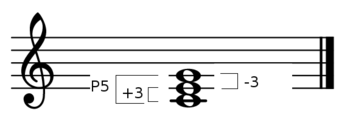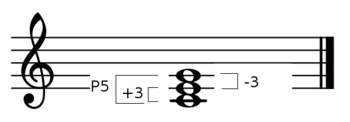We will learn how to identify triads in the same manner as scales and intervals. We will begin with major triads.
Major Triads
You will recall that triads are made by stacking thirds. Its members are called the root, third and fifth. It’s useful to know the interval content of a major triad: it has a major third and perfect fifth above the root. The distance between the third and fifth is a minor third. We often name a triad by its root note and quality, for example, C major:

C Major Triad
Learning to identify major triads by sound, is as simple as learning how to sing them. If we use solfege, the syllables are do mi so. We will continue to use the same methods as in the previous two articles.
- Start by singing a major scale up to the fifth: do re mi fa so
- Now sing re and fa silently: do (re) mi (fa) so
- And finally sing do mi so.
With triads you could also sing them both ascending and descending: do mi so mi do.
Now that you can sing back a major triad, try reproducing the following four major triads. You will first hear a triad with some time to sing it back, then you will hear the next one You may also wish to pause the player after each triad if you need more time:

Four Major Triads – do mi so
Minor Triads
Now we can take a peek at minor triads. Minor triads have a minor third and perfect fifth above the root. The interval from the third to the fifth is a major third:

C Minor Triad
The solfege for minor triads is la do mi. Give yourself a starting pitch and sing the first five scale degrees of a minor scale, then work up to the triad as before:
- la ti do re mi
- la (ti) do (re) mi
- la do mi
Listen and sing back the following minor triads:

Four Minor Triads – la do mi
Now you can test your skills. You will hear six triads – identify whether the triad is major or minor:
Harmonic Form
Before moving onto diminished and augmented triads, we should spend a little time with non-arpeggiating triads. The following example has three major triads followed by three minor ones. Play the complete example, just listening to quality of the chords:

Three Major and Three Minor Harmonic Triads
Now play the first chord only. See if you can hear and sing back its three pitches. You may have to fish around a bit, but that’s okay. You may also wish to work with you instrument. Play the chord, and sing a pitch from it. Figure out if you are matching the root, third, or fifth, then sing the rest of the triad. Replay the chord, and sing it from the root through to the fifth.
Allow yourself the time that you need to develop this skill. It only takes a few seconds to read this paragraph, but it might take a few practice sessions to develop this skill.
Make sure you take these lessons at your own pace. If you have any questions, please leave a comment below or come ask in our forums. The next part of the series continues on the topic of triads, looking at diminished and augmented triads: Learning to recognize triads, Part 2









Three part harmony is very tricky. I prefer to do it from the top down. Soprano, alto, tenor is the method I prefer even though it is usually taught from the bottom up, like tenor, alto, soprano.
It's very interesting that you're coming to triads from a choral perspective. Could you explain a bit more about using 'soprano, alto, tenor' to recognise triads?
hi hw can we differentiate harmonic major or minor triads?
Hi Sanjaya,
The best approach is to get solid on major and minor third intervals first. If you can distinguish those in their harmonic form, you should find it quite easy to distinguish major and minor triad chords.
Hope that helps!
Chris: I think someone mentioned this in another post, but it would be helpful if the lessons about intervals were more interactive, so the student would know if he got the answers right. (As in the first module about pitch).
Sorry about my slow response. As you say, the subject of intervals is a big bite to chew!
Hi Melissa,
Thanks for the Ear Expansion feedback. We're actually working on a new online ear training ( https://www.musical-u.com/ear-trainer/ ) which features more in-depth interval recognition practice like our RelativePitch iOS app.
I'll make sure you're added to our early access mailing list for it!
Best,
Christopher
Looking forward to it!